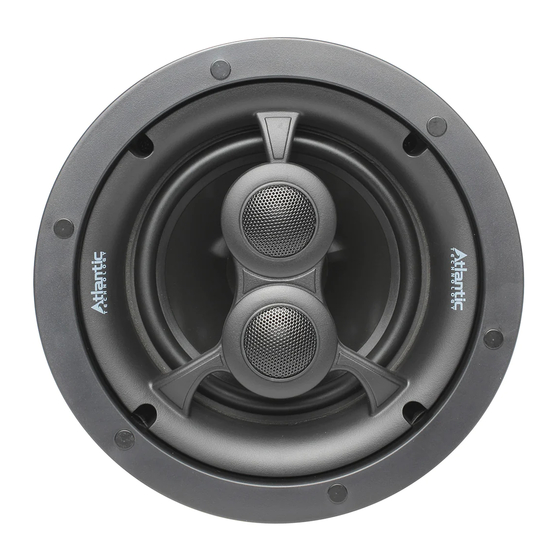スピーカー Atlantic Technology ICTS-6.3のPDF インストレーション・インストラクションをオンラインで閲覧またはダウンロードできます。Atlantic Technology ICTS-6.3 2 ページ。 Trimode ceiling speakers

ICTS-6.3
I C
and ICTS-8.3
TriMode Ceiling Speakers
T S
™
Installation Instructions
Thank you for purchasing Atlantic Technology speaker products.These
unique,TriMode speakers solve myriad surround sound and distributed
audio installation problems. We work very hard to ensure that all of
our speakers consistently deliver exceptional performance and value.
We hope you enjoy them to their fullest. Please take a moment to read
these instructions so you can get the most from your speakers.
Mounting Specifications
These speakers are intended for mounting in a ceiling,in material rang-
ing from 0.5 inches to 1 inch thick. They require at least 4-3/8 inches
for the ICTS-6.3 and 4-7/8 inches for the ICTS-8.3 clearance behind the
front surface of the ceiling. The mounting opening for the ICTS-6.3 is
7-7/8 inches in diameter.The mounting opening for the ICTS-8.3 is 9-5/8
inches in diameter. These speakers will work equally as well in a wall as
in a ceiling, however note that they require more mounting depth than
is normal in a 2x4 studded wall.
Operating Modes and Locations
Mono Mode Use Mono mode when the speaker will play a single
channel of information (as either the left or right channel of a stereo pair
of speakers).When used in Mono mode,both tweeters reproduce the same
signal. In Mono mode the speaker can be located anywhere within the
listening area. Generally however, it's best to keep it at least 24 inches away
from any wall boundaries (ceiling/wall/corner).Placing any speaker in close
proximity to other boundary surfaces will always"color"the sound that the
speaker produces.Even speakers that incorporate frequency adjustments to
compensate can only make small improvements to the detrimental effects
of boundary reflections. The more directly under the speaker you are, the
more high frequency information you will hear. Should you be using two
speakers in Mono mode to reproduce stereo, consider where the majority
Figure 1
Tweeter Dispersion Pattern
When set
to Mono
When set
to Stereo
of the room's occupants will be most
of the time. Then try to locate the
speakers where the listeners will get a
reasonable balance of sound from both
speakers.When wired in Mono mode
the tweeters interact strongly, chang-
ing the dispersion pattern of the high
frequencies as shown in Figure 1.
Important Note: DO NOT rotate
the tweeter assembly or damage
will occur. To achieve the desired
dispersion pattern, rotate the entire
speaker assembly before mounting.
This can and should be used to your
advantage by rotating the speakers
when you install them in order to
properly align the tweeters. This way
you can exert some control over the
Model ICTS-8.3,
ICTS-6.3 is similar
spread of mid and high frequency sound throughout the room and hence
improve the system's performance.
Stereo Mode In Stereo mode each of the woofer's dual voice coils and
the tweeters receives their own signals.The result is stereo reproduction
(albeit with limited separation) from a single speaker.This is particularly
advantageous in distributed audio systems where there is a desire to have
stereo sound in many rooms,but with as few speakers as possible.Unlike
so many ceiling speakers,the ICTS-8.3 and ICTS-6.3 use very high quality
component parts and sophisticated designs to deliver excellent sound
quality; sound quality so good that it will surprise you.When installed
as a single point stereo speaker it's typically best to locate the speaker
as centrally within the listening area as possible. Directly in the center
of the room, or in the middle of the prime seating area.
TriVector
Surround Mode TriVector mode puts the two tweet-
™
ers in each speaker out of phase with each other. The result, when you
sit centered on the tweeter array, is a non-localizable sound field that
helps re-create the surround field intended by the movie's director.
Since the goal of Home Theater is to get you "lost in the movie, " a
diffuse surround field almost always works best. To that end the ideal
location for most diffuse surround speakers is directly to the sides of
the prime listening area. However, in many rooms there's simply no
place to conveniently place speakers to the sides. Until the introduction
of Atlantic's TriVector ceiling surrounds, the ceiling was an often used,
but generally less than ideal alternative.
When used in TriVector mode these speakers are best placed in the
ceiling to the sides of the prime listening location, with the tweeters
aimed towards the front and back of the room. You can also place the
speakers to the side and slightly forward or back of the prime listening
position, keeping the tweeter orientation as noted above. There's a 15
degree"window"of placement forward or back of the listening position
that is acceptable.But note that any more forward or back and you'll lose
the diffuse effect. Also note that, due to the low midrange frequencies
coming from the woofer, if you place the speakers directly over the
listening position there will be a fair amount of localizable surround
sound even when the speakers are set to TriVector mode.
